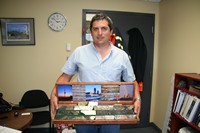In 1996, a hole drilled as part of a Falconbridge exploration program intersected a 30-centimeter wide chalcopyrite vein and revealed an off-hole geophysical anomaly. The finding was mildly interesting and merited some follow-up, but five years came and went before the company got around to it.
“They followed up with another geophysical survey using newer technology and drilled off a wedge cut, branching off and intersecting the target,” said Greg Snyder, Nickel Rim South’s geology lead.
The once in a lifetime discovery revealed more than 80 metres of footwall mineralization. So began the Nickel Rim South saga.
Another 43 holes were subsequently drilled to define the zone, and some of them intersected contact mineralization. Early in the project, said Snyder, the company realized there were two zones – one on top of the other.
Nickel Rim South’s location on the eastern rim of the Sudbury Basin, a mere nine kilometres from the company’s smelter, speaks volumes about the city’s natural endowment. Even after more than 100 years of mining, bonanza-type discoveries are still being made in the Sudbury Basin, and right under everyone’s nose.
The mineral resource at Nickel Rim South is estimated at 18.2 million tonnes, made up of 8.2 million tonnes of contact ore and 8 million tonnes of footwall ore. Grades early in the mine life average 2% nickel and 1% copper in the contact zone and 2% nickel and 7% copper in the footwall zone, significantly higher than average grades for the Basin as a whole. The ore also contains high precious metal grades averaging 0.6 g/t gold, 1.7 g/t platinum and 1.8 g/t palladium.
Xstrata Nickel, which acquired Falconbridge in August 2006, has calculated a 15-year mine life based on current reserves.
“These orebodies are very hard to come by,” said Snyder. “We’re exploring at depths of 1.5 to two kilometres with little spaghetti noodles from surface. Laterally, this deposit is only 300 metres in strike length. Vertically, it’s about 600 to 650 metres and it’s between 10 to 75 metres thick, so it’s a very difficult target to hit from 1.5 kilometres away. When you have tens of kilometres to explore, it’s very difficult to find these little pockets. There’s more to be found, but it’s very challenging and very expensive.”
Falconbridge’s Sudbury exploration team received the 2005 Bill Dennis Prospector of the Year Award from the Prospectors and Developers Association of Canada in recognition of its discovery.



.jpg;w=120;h=80;mode=crop)